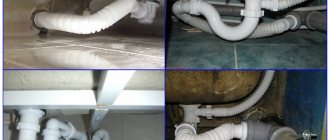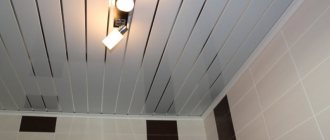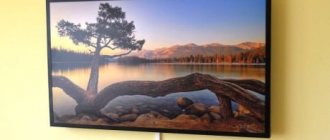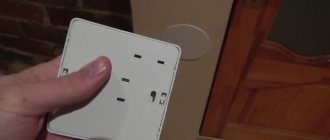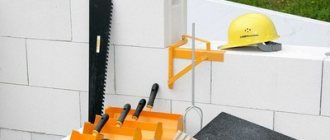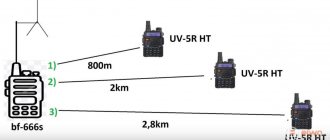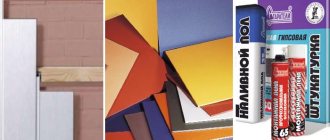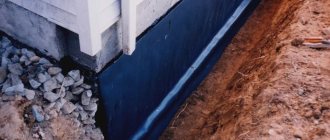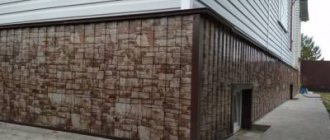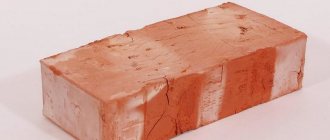Advantages, relevance of finishing the base with stone
The base for dirt, wind, mechanical influences, moisture is the most vulnerable place of the entire building. Water has a particularly destructive effect on the foundation. Moisture from melting snow and rain accumulates near the outer surface of the base, saturates the adjacent layers of soil, and enters the material of the supporting structure. Internal condensation flows down and is also absorbed into the foundation elements, coming out where it can evaporate. Freezing, the moisture in the surface layer increases in volume and breaks the structural bonds of the raw material.
The result of excess moisture on the foundation
These factors gradually destroy the foundation, causing the entire structure to suffer. First, external cracks will appear in the plaster or outer layer of finishing. After the first stage, the even more defenseless surface will begin to crumble and fall into pieces. Therefore, protecting the basement of the building is important. Finishing is a waterproofing barrier for the outside, a vapor-permeable layer for evaporating internal moisture.
One of the methods of base protection is cladding with decorative panels in the style of finishing with natural stone.
Stylish, beautiful, reliable
Advantages of the method:
- Low weight of piece products. They do not load the structure being closed, they are easy to install by one person, the elements of the plinth protection are very securely secured with a locking system and standard fasteners.
- Strength. The characteristics are several times greater than those of elements for facade walls. The properties of basement siding are constant even with significant temperature changes, high humidity, strong wind, mechanical and shock influences.
- Constancy of shape and color.
- Durability. 30 years is only the warranty period.
- Range. There are many imitations, shapes, colors, and options for the external relief of panels.
- Ease of installation, dismantling, replacement of individual products. The process does not require skills, knowledge of techniques, or a complex tool. Installation is carried out using a dry method, when the solution is not allowed to dry.
- Multifunctionality. The products can also become the outer layer of the insulating “pie” for the basement surface, cladding the rest of the building’s façade. Although they are decorative, they can provide ventilation for the facade, cover elements of a pile-screw foundation, and enclose additional utility rooms under such houses.
- View. Imitation of stone helps to perceive the base of the building as a reliable, massive element. The color and relief of the siding reinforces the visual sense of balance of all parts of the house.
- Availability. Cladding is cheaper than natural building materials.
- Easy to maintain the sheathed base surface.
Flaws
Against the background of the listed advantages, it is difficult to take the small disadvantages seriously.
- Color restrictions. In general, soft natural shades are natural for stone panels. But if you really want to achieve the effect, you can order custom siding from the manufacturer.
- Polymer cladding is not resistant to high temperatures and open fire. But fire safety is observed intuitively by the owners, and according to the rules, fires and barbecues are located at a safe distance from the house. Homeowners need to ensure reliable insulation of external electrical wiring and not work near the building with a grinder or welding.
- Manufacturers do not provide elements for neat design of organized ventilation, inspection hatches, and pipe insertion points.
- It is difficult to hide the artificial nature of the installed cladding from the human eye, which determines the rhythmically repeated pattern of the assembled panels.
Stone panel materials
Before choosing, you need to understand what advantages or disadvantages characterize standard products made from different materials. The classification of panels is based on the differences between products based on the raw materials used.
Types of panels
Let us briefly examine the features of siding.
- Fiber cement. The base is cement (90%). The products are environmentally friendly, fire and weather resistant, most naturally imitate any natural stone, and can be installed using the wet method. Among the disadvantages, we highlight the ability to absorb moisture, reduced, compared to other types, mechanical stability.
- Vinyl. The most common, affordable type of foundation cladding. The products are thicker and stronger than façade siding. Disadvantages: the material becomes brittle in severe frost; the outer coating without a protective layer can be destroyed under the influence of ultraviolet radiation.
Comparison of siding for facade and basement:
- Metal. Colored polymer protective coatings are applied to the pressure-formed relief of a galvanized steel sheet. The resulting panels are durable, wear-resistant, and fire-resistant. The main disadvantage is that it is difficult to obtain ideal joints of adjacent elements during installation.
- Acrylic. Acrylic resins added to the material help to obtain basement siding with improved properties. Due to their additional resistance to extreme temperatures, UV radiation, abrasion, and aggressive substances, acrylic panels are popular like vinyl.
Sample of sheathing with acrylic coating
Sandwich panels with outer layers made of the listed materials can be used. It is very rare to see a stone finish made from cement bonded particle boards. This material can additionally act as permanent formwork.
Cement-bonded particle board with an outer layer of natural stone chips
Main manufacturing companies
Based on the popularity of manufacturers of high-quality plinth materials with imitation masonry, the following companies can be distinguished:
- Hlzplast produces popular Wandstein panels, which are of excellent quality and are the product of a Russian-German joint venture. Stone variations are most often made in dimensions of 79.5 x 595 cm. The range of stone imitation is quite large: flat layered stone, various convex and straight stone blocks. Accordingly, there are quite a lot of color options;
- Novik is a Canadian manufacturer. Makes imitation of hewn, field, river, and wild stone. Differs in a variety of colors. Panels can be of different sizes: each type of masonry is different from the other;
- Docke is a German brand with factories in Russia. High quality products, “stone” variations are presented in a variety of colors and textures. The production principle is to cast the material, which ensures a long service life;
- Alta-profile is a Russian manufacturer. Produces the thickest panels compared to analogues. It is one of the most popular in the Russian construction market. The panels are available in a wide range;
- Grand Line - Vox panels. It specializes in Russia, is a sales leader among building materials, and is distinguished by high-quality products.
Each manufacturer systematically modifies production and improves the quality of its own products, has modern equipment and qualified employees.
What determines the cost of the material?
The production process of base protection is fully automated. The resulting finished product has stable quality and the required characteristics. Identical equipment and a similar technological process cannot greatly influence the wide variation in the cost of panels from different manufacturers.
A fair increase in the price of panels occurs due to the use of higher quality raw materials and an increase in the thickness of the product. Other reasons are an additional payment for the brand, the release of a new fashionable collection of facing materials with an exquisite texture.
The quality of basement siding offered by many domestic manufacturing companies is not inferior to products from abroad. The purchase costs 1.5-3 times cheaper.
Panel selection
Before choosing a specific sample for future cladding, you need to answer the questions:
- Does the foundation need to be insulated?
- Will the façade require ventilation?
- Will the cladding be installed using a wet or dry method?
- What size should the cladding elements be?
- Will the work be done independently or by craftsmen?
- Will you need support or strength lathing?
- How much do you need to spend?
Having clarified the listed points for yourself, you can select samples according to pattern, shade, relief, not forgetting about strength.
Siding
The following tips will not be superfluous:
- The front side should not have mechanical damage or defects, the paint layer should be uniform, the color of elements of the same batch should be the same, without halftones.
- The thickness and rigidity of the material is assessed.
- Checking the easy clicking of the locking system, tight connection (without gaps) of several elements.
- Product certificates are being studied. Its characteristics are compared with the necessary requirements for the cladding of a specific basement structure.
How to choose the right one
It is sometimes quite difficult for a non-professional to decide on the choice of material. Having a superficial understanding of the material, it is difficult to immediately understand what points to pay attention to. Only during installation or operation can you notice the deficiencies of the coating.
Here are some tips to help you avoid mistakes when choosing a basement covering:
- during inspection, it is recommended to inspect the joints of the parts: they should not have gaps and have a tight connection;
- you should check the locking parts: easy latching will free you from problems during installation;
- the material must be thick enough and have rigidity due to the specific purpose;
- the front surface of a separate sheet must be uniformly painted, must not have chips or scratches, parts of the same batch must not differ in color;
- You should be wary of inexpensive types: they may be of poor quality, which will affect the performance characteristics of the coating.
In addition, it is recommended to choose products from reliable manufacturers; when purchasing, it is advisable to familiarize yourself with the certificates of conformity of the purchased materials and quality certificates.
Installation of protective sheathing
If you pay attention to detail and carefully follow the technology, the installation of panels will result in the expected result.
What tools will you need?
First, here is a list of universal tools:
- marker, pencil;
- hammer;
- ruler, tape measure, square;
- building level;
- knife, scissors;
- any available cutting tool - hacksaw, grinder, jigsaw, circular saw.
Depending on the materials of the siding, plinth, and sheathing frame, you may need an impact drill, a hammer drill, a screwdriver, and a welding machine (for attaching the sheathing to a metal pile foundation).
Preparing the base for installation
Large defects on the surface are repaired, and strongly protruding areas are leveled using regular scraping. The remaining small differences are not a hindrance. A more ideal plane will have to be obtained before “wet” installation. Old loose plaster, oil, grease stains, moss and dirt should not remain on the base.
You'll have to work hard to prepare for the sheathing.
Then, the installation of lathing made of wooden beams or galvanized profiles is carried out. Taking into account the size of the insulation and panels, the required frame pitch is determined vertically (usually equal to 0.5 of the length of the base panel) and horizontally (0.5 of the width of the panel).
Vertical sheathing strips are additionally secured from all corners with a distance from them of no more than 0.1 m.
Procedure
Stages:
- Installation at the level of the lower starting bar. Gaps (4-6 mm) are left between the products to compensate for thermal expansion.
- Install corner elements.
Corner elements make installation easy
- Sequential installation of rows of basement siding from left to right with fastening of products to the sheathing. The fastening screw should not press the panel hard. It is unscrewed a quarter turn so that the lining reacts to temperature changes without deformation. The product is cut to the required size.
Rules for fastening with self-tapping screws
- The work is completed by installing a metal or plastic ebb, which covers the horizontal transition section of the protruding plinth, the top of the siding.
Installed drip sill
The considered technology for organizing the protection of the base is simple, but allows you to get a good result. In addition to increasing its service life, the building will be distinguished by its elegant design.
An example of using stone-look panels to protect a façade or plinth:
Average score of ratings is more than 0
Share link
Comments There are no comments yet, but you could be the first...
Preparation for installation
In addition to the ease of installation of the panels themselves, we note that the base of the house does not require any complex preparation, as, for example, would be the case with plaster. Before covering the foundation with basement siding, it is necessary to clean the basement from any dirt, debris, etc., and then treat it with antiseptic substances to prevent the appearance of mold and fungi.
When all the procedures are done, pay attention to the unevenness of the walls. If the walls have curvatures and defects, this can be easily corrected with lathing, but if you don’t think about it in advance, you can face a lot of problems.
When installing basement siding with your own hands, in addition to the panels themselves, you need to have the entire set of necessary tools and components available. Tools include:
- Screwdriver or drill;
- Level (water or infrared);
- Bulgarian;
- Hammer;
- Construction knives and scissors;
- Measuring tape and pencil for making marks.
Accessories:
- Self-tapping screws. We will need them throughout the entire work with siding and sheathing, so we need to buy self-tapping screws with a reserve. Also, it is worth purchasing several attachments for a screwdriver;
- Metal profiles and corners for lathing. In addition to the usual long profile, a large number of specific strips (starting, finishing, connecting, etc.) and corners (external, internal, etc.) are used in the installation of siding;
- Thermal and waterproofing. If you still decide to install a layer of insulation or waterproofing between the panels and the base, then its area will be approximately equal to the area of the installed panels (which we will calculate later).
Determining the amount of materials for installing basement siding is not difficult; the calculation is quite simple. First you need to calculate the area of the surface involved, that is, the base of the house; to do this, you need to multiply its height by its length. Afterwards, you need to divide the resulting number by the area of one panel, which is calculated in the same way.
In addition, on each pack of siding the total area of the package is written, so you can divide the area of the plinth by this value, and we will get the number of packs. It is also better to calculate the costs of siding in advance; the price of plinth panels can range from 550 rubles to 1,500 rubles per square meter. The price of siding greatly depends on the material from which it is made.
The area value we obtained can also be used when purchasing insulation and waterproofing, since when calculating the amount of these materials, the area of the surface to be covered is taken as a basis.
The profile for the sheathing is calculated individually, and there is enough of it needed to cover the entire length of the base; the vertical and horizontal distance between the profiles will be 50-60 cm. It also needs a certain margin, but fortunately, unlike siding panels of a certain model range, a metal profile can be Always buy more at any hardware store.
